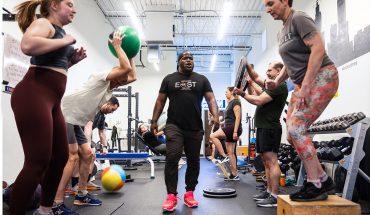by Charles Upchurch
photographs by Lissa Gotwals
Chris Hoina is ready to go ballistic. He has trained for this. To be explosive. To fly.
He wears only a skin-tight speed suit, spiked shoes, and an alpine racing helmet that will pierce the air as he rockets head-first down a mile-long chute of ice. A steel sled three feet long and 16 inches wide will shoot him through whipsaw turns before a shockwave of centrifugal force slingshots him downhill at 80 miles an hour.
There is no steering mechanism. No brakes.
“I’ve always been a bit of an adrenaline junkie,” said Hoina, “but this is insane.”
Welcome to the slightly unhinged, daredevil realm of the skeleton.
How in blazes does a former Air Force parachutist from Cary end up as one of the 0.00001% of the world’s population competing in skeleton racing? Here in the United States – a country of 312 million people – there are 20 guys who do this. Six of them comprise Team USA, the U.S. national men’s team selected by the USA Bobsled and Skeleton Federation. The other 14, hopefuls like Hoina, make up the men’s development team. Success at national competitions and team trials – even a shot at the Olympics – is often determined by tenths, even hundredths, of a second.
Hoina likes his odds. His best time at Lake Placid – one of the two U.S. Olympic training runs – is only a second off World Cup pace. At the 2012 U.S. Skeleton National Push Championships (a strength and speed combine using sleds on rails) he placed sixth, only .2 seconds behind the winning time.
It is an unlikely sport, with many unlikely paths leading to it. Consider Hoina, 29. An Apex High School graduate, he joined the Air Force in 2001 at 19 and was selected for the Search, Evasion, Rescue, and Escape, or SERE program. A former standout soccer player, Hoina excelled at this extreme survival and endurance training. Four years of it taught him discipline, confidence, and no small measure of courage. Along the way, he became a top freefall HALO (high altitude, low opening) jumper.
Back in Apex in 2006, Hoina took up mountain biking and raced competitively while figuring out what to do with his life. But after being paid to jump out of planes and fly, he says, everything seemed so…safe.
Then, in 2009, while working as a personal trainer at the intense Athletic Lab in Cary, Hoina was researching the web site of the U.S. Olympic Committee when something caught his eye. Something fast. Something crazy. That’s like flying, he thought. I can do that.
Cary recruit
Like bobsled teams, skeleton athletes are recruited and developed through an application process. Sliders typically come from power and sprinting sports like football and track and field, so Hoina was stunned when his online application was accepted and he was invited to attend the national skeleton training combine.
He got to work, committing himself to a regimen of Olympic-style weightlifting and short sprint training, designed to build power and explosiveness. He got stronger and faster, but he still had to become a slider. He decamped to Lake Placid for the winter. As the 2010 Winter Olympics were gearing up in Vancouver, Hoina was in upstate New York making his first full-length, full-speed skeleton runs, and trying not to die.
“I had no idea what I was doing,” he admits.
Hoina will tell you that you do not drive your way down an Olympic run, you will your way through. You memorize the entrance and exit of every banked curve. If you’re fast and clean off the start, diving prone into the saddle, arms flat against your sides, you’ll anticipate the weight shifts that guide your sled to the perfect line, and if you hit turn 10 right, you’ll feel it pay off in turn 19. He’ll tell you that when you come screaming out of that big shoulder curve on a 90-degree bank doing better than 75 miles per hour, and hit the long straight alley that drops slightly away, your body separates off the sled and floats, because for a weightless, laugh-out-loud, Isaac Newton-be-damned moment, gravity can’t catch you, and you are flying.
Then, like most rookies, somewhere between hope and glory, you crash. But if you’re Chris Hoina, you duct tape your cleaved chin back together, clean up the blood the best you can and head back up to the start house, because you will not be wasting a run today.
This season, Hoina will train again at Lake Placid and Salt Lake City as he prepares for the U.S. Nationals in March. His work as a personal trainer is helping to fund it all, and he’s got money saved from GI Bill education grants as well. Olympic team trials will be held next fall for the 2014 Winter Games in Sochi, Russia. But if his sights move to 2018 and Pyeongchang, South Korea, Hoina will soldier on, undeterred. Canadian Duff Gibson won the 2006 gold medal in skeleton at age 39.
In 2018, Cary, North Carolina’s own Chris Hoina will be 35, a veteran slider of eight years, charging with unbridled abandon along a most unlikely path.





